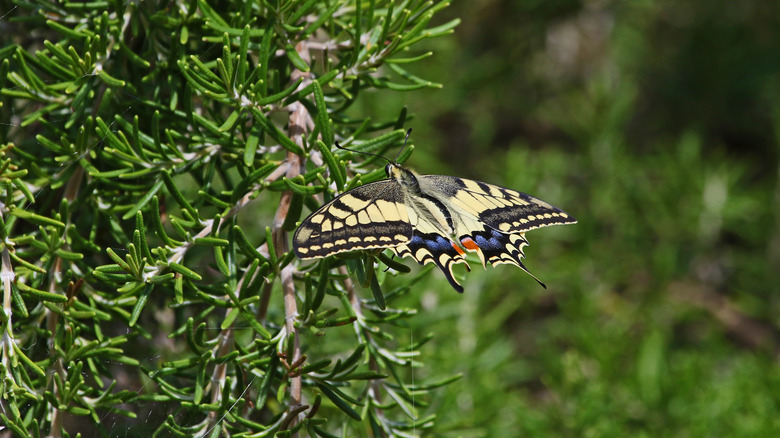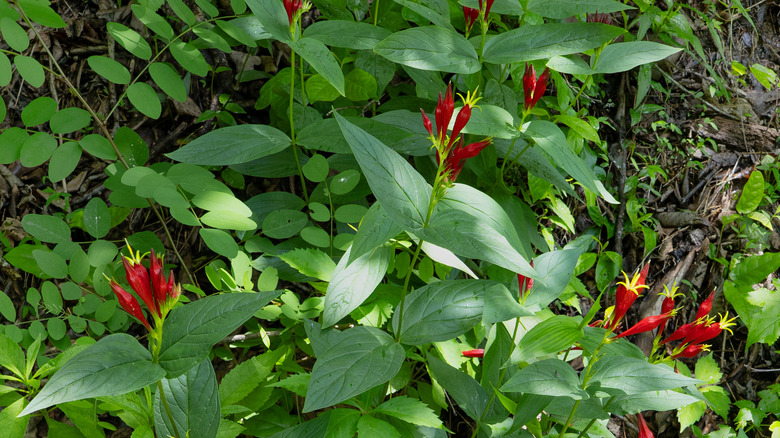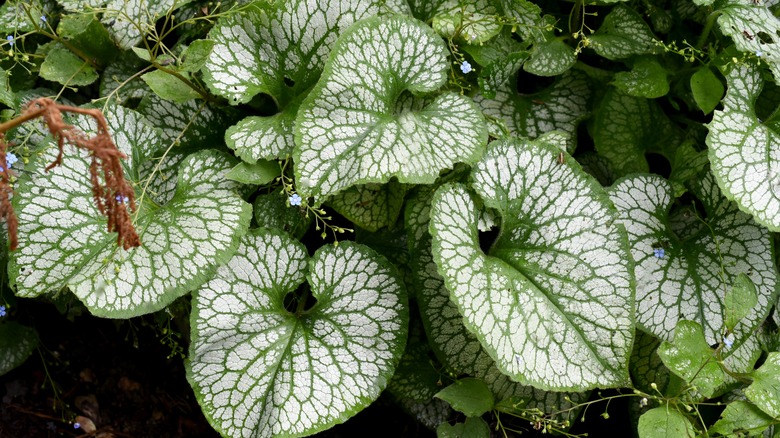18 Beautiful Ground Covers That Are Great For Preventing Soil Erosion
Soil erosion can have a devastating impact on the environment, especially your beloved garden. Harsh weather conditions like heavy rain that creates runoff, winds that lift soil particles away, and landslides on steep slopes can all be culprits. And don't forget about human behavior. Overfarming, construction, uncontrolled animal grazing, and deforestation can make soil vulnerable and less stable.
Using the right soil from the beginning is the first step for homeowners to take in preventing erosion —some compost, topsoil, and 1-2 inches of mulch can do the trick. Also, sandy, loamy soil is more resistant than soil overladen with clay.
However, your green anti-erosion practices don't stop there. Several non-invasive species provide helpful ground cover while sometimes suppressing weeds. It is best to use native plants as they establish their roots deeper and faster, encourage beneficial wildlife, and need less watering. Plus, you have a variety of blooms, textures, color patterns, and aromas to fill your space while having the piece of mind that it fits in the environment. As you review this list, you can find several beautiful plants to use on their own or in vibrant pairings for protective ground cover to prevent soil erosion.
1. Creeping juniper
When you need an easy-to-grow ground cover that can protect sloped backyards, consider planting creeping juniper (Juniperus horizontalis). The species is native to North America (especially in the northern regions) and parts of Canada. Expect it to spread anywhere from 5-8 feet while only growing up to 18 inches. Its green to blue-green may turn purple in winter and it also works in rock gardens or coastal landscapes due to salt tolerance. Its tolerance extends to drought-prone areas after its roots are established. Are you dealing with hungry rabbits or deer? Luckily, those cute vegetarians don't feast on these needle-like plants, but aphids, bagworms, and spruce spider mites do!
2. Creeping phlox
Common names for creeping phlox (Phlox subulata) include ground pink, moss pink, and flowering moss. It is among the deer-resistant plants that will bring color to your yard, earning the genus name "Phlox" — Greek for "flame." Look forward to loose clusters of tubular lavender, pink, white, or reddish-purple blooms in spring that appear in mat-like formations reaching up to 6 inches high. While mostly native to the Appalachian Mountains, it is also native to central and eastern Canada and the United States. Your vibrant ground cover can resist deer and drought, but spider mites seek them in hot and dry conditions.
3. Climbing hydrangea
Prevent soil erosion with climbing hydrangea (Hydrangea anomala), a woody vine that climbs its support system by attaching to tiny rootlets. Glossy green, oval leaves partner with fragrant white flower clusters by July, and the plant can grow 30 to 80 feet in length as it establishes itself over the years. It's native to Japan, Korea, and Siberia; but, in the United States, its hardiness zones are 4,5,6, and 7. It works as ground cover in shady areas — but too much shade can reduce flowering. It's not considered invasive despite growing fast.
4. Cotoneaster
When spring arrives, so do the white flowers of rockspray cotoneaster (Cotoneaster horizontalis), which are soon followed by bold, red berries. As it grows in a fishbone branch pattern, this dense plant can reach 3 feet and spread 6-8 feet wide. It can be semi-evergreen to evergreen in southern climates but don't expect it to show out in hot summers. While it's not disease-prone, you should look out for leaf spot or cotoneater web worms. Use stem cuttings for propagation and keep soil well-drained.
5. Creeping rosemary
Like one of its equally aromatic cousins, creeping rosemary (Rosmarinus officinalis 'Prostratus') brings a distinctive fragrance to your garden as its needle-like foliage spreads out to prevent soil erosion. Look for pale blue blooms in spring and summer as the plant sprouts up to 2 feet tall and spreads 3 feet wide. It prefers full sun and is mostly disease-free. Are you looking for fragrant ground covers that can help deter pests? Its strong aroma can repel deer while attracting hummingbirds, butterflies, and bees.
6. Wild Ginger
Not to be confused with the therapeutic root, wild ginger (Asarum canadense L.) is a dense ground cover characterized by heart-shaped leaves that mostly grow on the eastern side of the United States. A purplish-brown cup-like flower sits at its base and is popular with pollinating ants and flies. Expect it to grow 6-8 inches high and wide annually. This ground cover is perfect for shady areas of your yard and garden. Don't worry about deer, who avoid this plant. Instead, watch out for butterflies metamorphosing from the pipevine swallowtail caterpillar!
7. Honeysuckle
Instead of worrying about how to get rid of Japanese honeysuckle if it takes over, plant its non-invasive cousin, the coral honeysuckle (Lonicera sempervirens), instead. Showcase its red and yellow blooms by planting it in full sun. In addition to its serving as ground cover, you can train it to climb nearby structures like fences or arbors. As it establishes, expect to hear morning tunes from hummingbirds and experience frequent sightings of the spring azure butterfly — a pollinator its blooms host. Unfortunately, less friendly creatures like aphids also love this plant. Other common names include trumpet honeysuckle and woodbine.
8. Alpine lady's mantle
Alpine lady's mantle (Alchemilla alpina) is a perennial, densely growing plant that covers your ground with pale green leaves consisting of five to seven leaflets. Each leaflet is trimmed with silvery edges and silky hairs. Look for blooms in summer. Use this plant to cover smaller areas in your yard under full sun, or part shade — they especially look nice under trees. It can grow about 6-8 inches high while spreading from 8 inches to 1 foot.
9. Hosta
Hosta (Hosta spp.) has over 70 species and 3,000 cultivars to consider for your yard. Look for bell-shaped flowers that range from white to violet. This pollinator-friendly plant can be used instead of the invasive yellow archangel. Even if you plant hostas in non-native zones such as the Midwest, they don't have a pattern of being invasive. This plant pairs well with other ground covers such as heartleaf brunnera (Brunnera macrophylla), Pennsylvania sedge (Carex pensylvanica), Indian pink (Spigelia), or ostrich ferns (Matteucci). However, be aware that the ostrich fern may become aggressive without control.
10. Indian pink
In the southeastern United States, you may see clumps of Indian pink (Spigelia) in moist woods or along river banks. Its emerald green leaves and red tubular flowers — featuring a bright yellow interior that opens into a star shape — can reach 12-18 inches in height. Grow these perennials in shady areas as you look forward to the hummingbirds that pollinate them. Plant them in fertile and well-drained soil as you enjoy their lush green color all year. The red blooms show up in spring and summer. However, deer and rabbits won't show up to munch on them.
11. Siberian bugloss
The heart-shaped leaves of Siberian bugloss (Brunnera macrophylla 'Alexander's Great') will spread without invasiveness while displaying small bright blue flowers in spring. Plant this perennial with boldly veined leaves in full to part shade for textured and thick ground cover. While repelling deer and rabbits, this ground cover attracts butterflies and other pollinators. Siberian bugloss thrives in zones 3 to 8 while growing up to 1.5 feet and spreading up to 2.5 feet. These plants are relatively disease-free, but you may see snails or slugs taking a bite at times.
12. Sedge
You can easily grow Pennsylvania sedge, or just sedge, (Carex pensylvanica) to prevent soil erosion in full to part shade. This native to the eastern and central parts of North America has narrow grass-like leaves that may occasionally deal with smut, rust, or leaf spot. The sharp-leaved perennial is capable of self-seeding while growing up to 1 foot high and wide. It can be a creeping plant or sprout in loose colonies that thrive in cool climates. Other common names include rush, seersucker sedge, and oak sedge — for its tendency to grow near oak trees.
13. Creeping mazus
Creeping mazus (Mazus reptans) thrives in zones 5 to 8 and blooms clusters of showy lavender flowers that feature yellow and white markings. This ground cover can tolerate wet soil and grows about 2 inches tall. Enjoy its green foliage in winter when the climate is warm. If your landscape has a slope or bank, creeping mazus is ideal. It can also tolerate some foot traffic while resisting deer. However, be mindful of good maintenance with this plant, since it can develop invasive habits as the dense foliage can overgrow. Handle its potential overgrowth by pruning the edges.
14. Ostrich fern
Ostrich fern (Matteuccia struthiopteris) stands as tall as the bird it's named after. Your cultivated plants may arch or stand as high as 3 feet but can stretch up to 6 feet in the wild. Keep this medium green ground cover in rich, moist soil as it grows in clumps. It's a solid plant for those living in cool climates. By fall, the feathery, long foliage falls away in preparation for winter dormancy. It's not associated with any disease and is rabbit-tolerant.
15. American wintergreen
Common wintergreen, creeping wintergreen, eastern teaberry, and boxberry are among the several common names for the American wintergreen (Gaultheria procumbens), which can tolerate moderate shade and acidic soil. The oval leaves can bring fresh wintergreen or minty fragrance to your property. They naturally form a dense, protective carpet while providing a vibrant color contrast between the bold green leaves and red berries. Look forward to tiny bell-shaped white flowers in July and August. The tasty, fleshy fruit can attract wildlife, especially those hunting for winter food. Some of these animals include deer, red squirrels, the eastern chipmunk, and the ruffed grouse.
16. Shore juniper
Shore juniper (Juniperus conferta) is a conifer shrub that provides low, dense coverage spreading 6-8 feet and reaching 1-1.5 feet high. With blue-green fragrant leaves and prickly, pointed needles grouped in threes, it produces a berry-like seed cone fruit that goes from dark blue to bluish-black. Plant it in full sun in dry and sandy soil. Failure to drain the soil can produce cedar-apple rust and root rot. Not considering the environment is among the common mistakes everyone makes when growing groundcover plants, so avoid planting in locations that can drop below 10 degrees Fahrenheit.
17. Plantain pussytoes
When you plant plantain pussytoes ( Antennaria plantaginifolia), a native to the eastern United States, this perennial ground cover grows about 6 inches high and can spread up to 2 feet. Be careful when using compost and other organic matter as it can stress the plant. The ground cover consists of basal leaves that produce a central stem briefly bearing a small cluster of flowers for about three weeks in mid to late spring. Other names include everlasting, ladies' tobacco, and mouse ear.
18. Mouse-eared coreopsis
Mouse-eared coreopsis (Coreopsis auriculata), a low-maintenance perennial of the aster family, is easy to grow and is characterized by beautiful, long, yellow blooms. The showy radial flowers have about seven to 20 petals and measure about 1-3 inches. Songbirds are attracted to the plant as they eat the seed, and other pollinators enjoy the nectar. Unfortunately, deer also love the mouse-eared coreopsis. Drought isn't good, but the ground cover can handle humidity. If you don't properly drain the soil, crown rot can occur.


















